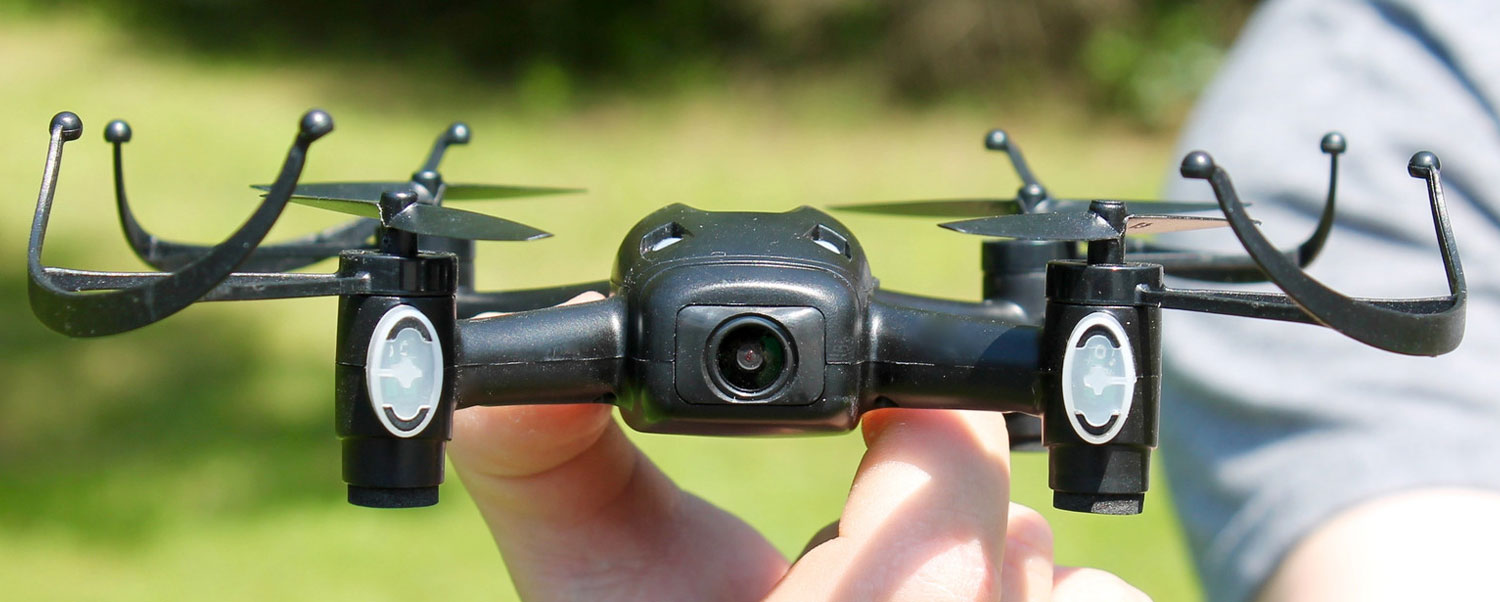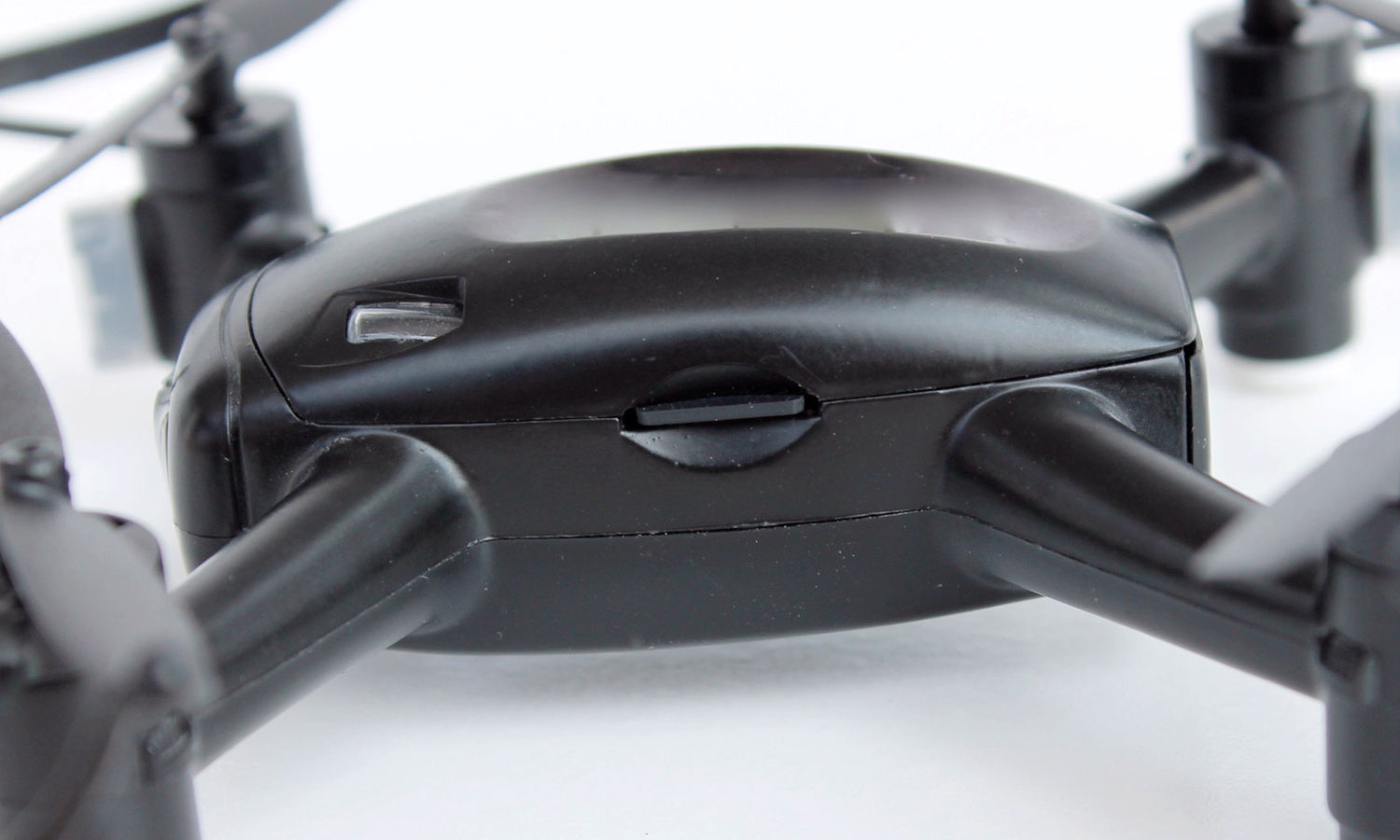Tom's Guide Verdict
Aspiring racers will love the speed and maneuverability of the Aerix Drones Black Talon, but the battery life is frustratingly short.
Pros
- +
Speedy drone with smooth, quick maneuvering
- +
Works with FPV goggles for racing
- +
Simple to fly and learn
Cons
- -
Video quality is poor
- -
Short battery life
- -
Screen hard to see in direct sun
Why you can trust Tom's Guide
Drone racing is a hot new sport, where high-powered drones fly around a course, competing for the fastest speed. It can be an expensive hobby, though: A professional racing drone can cost hundreds or thousands of dollars. For newbies to the sport, the $139 Aerix Drones Black Talon Micro FPV Beginner Racing Drone is a cheaper way to get started. While it may not be as fast as its professional cousins, it's a zippy little quadcopter with some interesting features.
Design
The Black Talon Micro is a medium-size drone, measuring 7 x 7 x 2 inches — nearly double the size of the Hubsan X4. The boxy body is made of matte black plastic and weighs about 2.5 ounces, which means it is small and light enough that it doesn't need to be registered with the Federal Aviation Administration. It feels solid; this isn't a drone that will shatter the first time it crashes. That's a good thing, because racing drones crash — it's what they do.

The 720p camera, which offers a wide 170-degree field of view, sits on the front. The lens is bigger than the usual smartphone camera lenses I've seen on low-cost drones such as the Skyrocket Toys Sky Viper v950HD. Most of those cameras are as tiny as a pinhead, but the Black Talon camera is almost penny-size.
The camera is set into the body, so it isn't likely to be scratched or damaged in a crash. On each of the motor mounts, a clear plastic cover sits over an LED that glows white for the back and blue for the front when the drone is turned on.

A microSD card slot is located on one side of the Black Talon Micro's body, which oddly leaves the card poking out slightly from the chassis. (We tested it with a 32GB microSD card.) This doesn't seem to affect the aerodynamics of the drone, though, and the card stayed in place despite numerous crashes and hard landings. However, if you don't insert the card at just the right angle, it misses the socket and falls loose inside the case. When this happens, the only way to retrieve the loose card is to crack open the drone body — and that's not simple to do.
The battery fits into a cavity in the back of the drone, firmly locking into place in the streamlined body. This small battery is a gum-pack-size lithium-ion battery that holds 530 mAh of charge. It can be recharged either inside the drone, or when removed. Either way, it uses the same USB charger, which is included.

On the top of each of the four motors is a 2.7-inch rotor, which shares the same matte black plastic look as the rest of the drone. In addition, each rotor is protected by a U-shaped guard. Unlike the rest of the drone, these guards feel very flimsy — but the idea is that they bend in a crash. That didn't quite seem to work out, though: One of them was already broken when I received the review unit, and another one broke shortly afterward in a low-speed crash. They did protect the rotor blades, though, so they did fulfill their primary purpose.
Get instant access to breaking news, the hottest reviews, great deals and helpful tips.
MORE: The Best Drones and Quadcopters on Any Budget
Aerix Black Talon Micro Specs
Rotors: 4 (2 blades per rotor) replaceable, 2.75-inch diameter
Battery Size: 520-mAh Li-ion, removable
Battery Life: 5/4 minutes (claimed/tested)
Camera: 720p video/1280 x 720 still image resolution
Smartphone Controlled: Yes
FAA Registration: No
Size: 7 x 7 x 2 inches (rotor tip to rotor tip, height including rotors)
Weight: 2.5 ounces
Controller
The Black Talon's controller comes in two parts: the main controller, and the FPV display that fits onto this. The controller uses four AAA batteries and looks like an off-brand Xbox controller, right down to the placement of the control buttons and sticks. Most drone controllers put the two control sticks side by side, but the Black Talon Micro controller has one on the top left, and one in the middle on the right. This placement will feel familiar to gamers but not so much to experienced drone pilots.
Around the sticks are buttons that activate various features. For instance, you can take a picture by tapping the left shoulder button, or start/stop video recording by holding down the same button. The directional pad below the left stick sets various features. If you push it up, for instance, you'll put the drone into stealth mode, where the bright LED lights are turned off. Push it down, and you'll switch among the three speed modes.

The FPV display looks like the pop-up screen on a GPS device — a 4.5 x 3.5-inch panel dominated by a large, bright 320 x 240-pixel LCD screen. This screen is bright and clear, but it's a little hard to see it in direct sunlight. Although you can still see the video, the icons for video and battery level get rather hard to make out.
There is a power switch, as well as a power socket, on the video display, but there are no other controls, touch-screen or otherwise. The display's battery, which has to be plugged in via an included USB cable, charges separately from the drone and controller battery. This battery lasted half an hour or so in our tests — more than long enough to exhaust multiple batteries on the drone.
When you take off, the Black Talon Micro will hover in place, maintaining a fixed altitude as you figure out the controls.
There are two radio connections linking the controller, drone and FPV display. The controller and drone communicate over a 2.4-GHz connection, while the drone sends back the video to the FPV display over a 5.8-GHz connection. We found that the controller-to-drone connection was solid even at distances greater than 50 feet, but the drone-to-video connection started to drop out at about 30 to 40 feet, producing grainy, noisy video and eventually vanishing at about 50 feet away. So, it is possible to fly the drone farther away than the FPV video allows. When the drone loses the signal, it hovers in place until it acquires it again.
MORE: Drone Buying Guide: Everything You Need to Know
The 5.8-GHz video that the Black Talon Micro sends is compatible with FPV headsets that work on this commonly used frequency band, such as the Spektrum Teleporter. However, unlike on most racing drones, there is no way to set the video transmitter to use different channels. This would have allowed several racers to use the same frequency band. Instead, it is fixed on one frequency, thus making it problematic to race multiple Black Talon Micros.
Flight
The Black Talon Micro is a bit smarter than most cheap drones like the Hubsan X4 and the Blade Nano QX RTF. It includes an air-pressure sensor that it uses to try to maintain a fixed altitude. It is also better balanced and more stabilized than some, and has a couple of preprogrammed 360-degree flip moves.
When you take off, the Black Talon Micro will hover in place, maintaining a fixed altitude as you figure out the controls. The altitude control definitely makes it easier to learn to fly this drone, as you can focus more on learning the finer points of flight rather than just trying to keep the thing off the ground.
It is also responsive, quickly reacting to the controls for speedy maneuvering. But it was somewhat prone to getting blown around by the wind; even a slight breeze pushed this small drone around.
The Talon also seemed to recover from crashes better than most. Often, it would bounce off the ground, right itself and then keep going — a useful ability for a racing drone.
And this thing can certainly go. When this drone was running in the highest-speed mode, we measured its flat-out speed at about 37 mph, which is very fast for a small drone. It won't keep up with its pro racing cousins (which can manage speeds of up to 80 mph), but it is definitely faster than the Hubsan X4, and plenty fast for beginners. The odd thing is that the wide view of the lens doesn't make it feel as fast when you watch the video. Indeed, it looks deceptively slow because things in the view don't pass out of the frame very quickly.
Photos and Video
The Black Talon Micro comes with a built-in camera that captures 720p video with a wide-angle (170-degree) view. That's great for seeing where you are and what is in front of you, but the quality of the video is very disappointing.
I found the video recorded by our review model very unattractive, with soft, fuzzy details and flat, unappealing color.
I found the video recorded by our review model very unattractive, with soft, fuzzy details and flat, unappealing color. Objects near and far looked blurry, and the colors often shifted while being recorded as the lighting changed. As the drone flew low over green grass, the grass turned into a green blur, and the tree branches were barely discernable. When the drone landed, the grass turned yellow as the camera tried to adapt to the changing lighting.
The video is definitely good enough to give you the feeling of being on board the drone and get a sense of what is around you, but it just looks nasty when you show it on a big screen. To be fair, racing drones aren't meant to take documentary-quality video; for that, you'll need a bigger drone with a better camera, such as the DJI Phantom 4.
Battery
Aerix Drones claims that the small, 520-mAh battery in the Black Talon Micro is good for 5 minutes of flying, but we found that to be a bit optimistic. We found it was more like 3 to 4 minutes of vigorous flight, after which the Talon would start blinking its LEDs and then land.
Spare batteries are essential, and that's probably why Aerix Drones is offering a more expensive version that includes three batteries and 10 sets of spare rotor blades. If you can spend an extra $50, this would be the preferred model to get. For $189, you get a more respectable 12 to 18 minutes of total flight time. That's a bit more expensive than drones like the Hubsan X4, which offers spare batteries for less than $5.
MORE: What the FAA's Drone Rules Could Mean for You
The price of spare batteries hasn't been set yet, but they are unlikely to be expensive. Each battery takes about 30 minutes to recharge with the included USB charger. The battery is a proprietary style; you can't replace it with any third-party ones.
Repairability
The prices for Black Talon Micro spare parts haven't been set yet, but they are unlikely to be expensive. Aerix Drones sells sets of rotor blades for other drones for about $15 a set. One set of replacement blades is included with the Black Talon Micro, and these are easy to swap in and out by simply popping them off with a knife or flat-blade screwdriver and then pushing a new one on. That's comparable with the price of spare parts for other similar drones.
Bottom Line
The $135 Aerix Drones Black Talon Micro FPV Beginning Racing Drone is an attractive intro to the world of drone racing. It's a simple-to-fly drone that shoots video that gives you a good feel for the thrill of the race. The company cut some corners to keep the cost down, though. Plus, the battery life is very short. The latter is a big concern; it is hard to get a feel for racing around the track when you have to swap batteries every 4 minutes or so.
Despite these downsides, the Black Talon Micro definitely fulfills its promise of introducing the beginner to drone racing. Take this drone to a proper race meeting, and you'll get flown off the track by faster, more maneuverable drones in short order. Nonetheless, it's a cheap way to get a feel for what this exciting sport involves.
Richard Baguley has been working as a technology writer and journalist since 1993. As well as contributing to Tom's Guide, he writes for Cnet, T3, Wired and many other publications.
